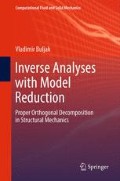Abstract
Numerical simulations have been established as a powerful tool used in practically all fields of engineering and science. A large number of commercial codes is developed to solve the, so-called direct problems (or forward problems), which consist of finding the solution in terms of response fields when a complete set of input data defining uniquely the solution is known. Since these codes require the knowledge of some parameters on which the solution depends, sometime in engineering practice it is required to solve an inverse problem, defined as the one where some of the “effects” (responses) are known but not some of the “causes” leading to them, namely parameters on which the system depends. These problems are tackled within, relatively young and still growing scientific branch which in modern literature (e.g. [1–3]) is found under the name of Inverse Analyses.
Access this chapter
Tax calculation will be finalised at checkout
Purchases are for personal use only
References
Groetsch, C.W.: Inverse Problems: Activities for Undergraduates. The Mathematical Association of America, Washington, D.C. (1999)
Liu, G.R., Han, X.: Computational Inverse Techniques in Nondestructive Evaluation. CRC Press, Boca Raton (2003)
Tarantola, A.: Inverse Problem Theory and Methods for Model Parameter Estimation. Society for Industrial and Applied Mathematics, Philadelphia (2005)
Ostrowski, Z., Bialecki, R.A., Kassab, A.J.: Estimation of constant thermal conductivity by use of proper orthogonal decomposition. Comput. Mech. 37(1), 52–59 (2005)
Yu, G., Wen, P.A., Wang, H.: An inverse method to determine boundary temperature and heat flux for a 2D steady state heat conduction problem. Proceedings of the ASME International Design Engineering Technical Conferences and Computers and Informational in Engineering Conference (IDETC/CIE 2008), New York. Paper number DETC2008-49811, pp. 1087–1093 (2008)
Li, W., Krist, S.A., Compabell, R.: Transonic airfoil shape optimization in preliminary design environment. Proceedings of 10th AIAA/ISSMO Multidisciplinary Analysis and Optimization Conference, Albany. Paper number AIAA 2004-4629, pp. 3650–3671 (2004)
Sobieczky, H.: Knowledge based aerodynamic optimization. Proceedings of 4th SST CFD Workshop, Tokyo, pp. 1–6 (2006)
Wang, B.T., Chiu, C.H.: Determination of unknown impact force acting on a simply supported beam. Mech. Syst. Signal Process. 17(3), 683–704 (2003)
Borsic, A., Comina, C., Foti, S., Lancellotta, R., Musso, G.: Imaging heterogeneities with electrical impedance tomography: laboratory results. Geotechnique 55(7), 539–547 (2005)
Damasceno, V., Fratta, D.: Monitoring chemical diffusion in a porous media using electrical resistivity tomography. ASCE Geotech. Spec. Publ. (GSP) 149, 174–181 (2006)
Oliver, W.C., Pharr, G.M.: An improved techniques for determining hardness elastic modulus using load and displacement sensing indentation experiments. J. Mater. Res. 7, 176–181 (1992)
Jager, A., Lackner, R., Eberhardsteiner, J.: Identification of viscoelastic properties by means of nanoindentation taking the real tip geometry into account. Int. J. Theor. Appl. Mech. AIMETA 42(3), 293–306 (2007)
Nakamura, T., Wang, T., Sampath, S.: Determination of properties of graded materials by inverse analysis and instrumented indentation. Acta Mater. 48, 4293–4306 (2000)
Van Vliet, K.J., Gouldstone, A.: Mechanical properties of thin films quantified via instrumented indentation. Surf. Eng. 17(2), 140–145 (2001)
Maier, G., Bocciarelli, M., Bolzon, G., Fedele, R.: Inverse analyses in fracture mechanics. Int. J. Fract. 138, 47–73 (2006)
Fedele, R., Maier, G.: Flat-jack test and inverse analysis for the identification of stress and elastic properties in concrete dams. Meccanica 42, 387–402 (2007)
Fedele, R., Maier, G., Miller, B.: Identification of elastic stiffness and local stresses in concrete dams by in situ tests and neural networks. Struct. Infrastruct. Eng. 1(3), 165–180 (2005)
Chen, X., Ogasawara, N., Zhao, M., Chiba, N.: On the uniqueness of measuring elastoplastic properties from indentation: the indistinguishable mystical materials. J. Mech. Phys. Solids 55(8), 1618–1660 (2007)
Bolzon, G., Maier, G., Panico, M.: Material model calibration by indentation, imprint mapping and inverse analysis. Int. J. Solids Struct. 41, 2957–2975 (2004)
Author information
Authors and Affiliations
Corresponding author
Rights and permissions
Copyright information
© 2012 Springer-Verlag Berlin Heidelberg
About this chapter
Cite this chapter
Buljak, V. (2012). Inverse Analysis: Introduction. In: Inverse Analyses with Model Reduction. Computational Fluid and Solid Mechanics. Springer, Berlin, Heidelberg. https://doi.org/10.1007/978-3-642-22703-5_1
Download citation
DOI: https://doi.org/10.1007/978-3-642-22703-5_1
Published:
Publisher Name: Springer, Berlin, Heidelberg
Print ISBN: 978-3-642-22702-8
Online ISBN: 978-3-642-22703-5
eBook Packages: EngineeringEngineering (R0)

